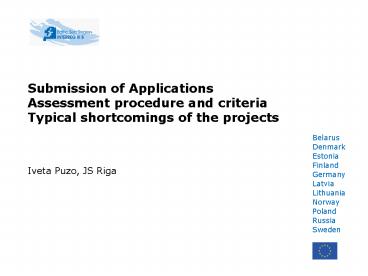Submission of Applications - PowerPoint PPT Presentation
1 / 19
Title:
Submission of Applications
Description:
8. Contract. PROJECT IMPLEMENTATION. 1. Project idea and partners. Submission of Application ... in accordance with the Section 8.4. of the Programme Manual; ... – PowerPoint PPT presentation
Number of Views:40
Avg rating:3.0/5.0
Title: Submission of Applications
1
Submission of Applications Assessment
procedure and criteria Typical shortcomings of
the projects Iveta Puzo, JS Riga
2
Submission of Application
3
Submission of Application
- One original and electronic version to be
submitted - To be filled in English
- Co-financing Statements from ALL partners
- Additional documents in accordance with the
Section 8.4. of the Programme Manual - Application has to be submitted no later than 4
December 2006 to the JS - Baltic Sea Region INTERREG III B
- Neighbourhood Programme
- Joint Secretariat Riga
- State Regional Development Agency
- Elizabetes iela 19, Riga LV 1010, Latvia
4
Additional documents for Tacis partners
- All partners applying for Tacis have to submit
- Partnership Statement
- Lead Partner has to submit
- Legal Entity Form, including the necessary
supporting documents - Financial Identification Form signed by the
Partner and the bank - Last available audited annual financial
statements including audits report of the Lead
Partner in the case that the requested Tacis
financing exceeds 300,000 EUR.
5
Additional documents for Tacis partners (2)
- In case the Lead Partner is not a local or
regional authority it has to submit additionally
the following documents - the complete statutes and/or articles of
association of the organisations, to justify
their organisational status as non-profit making - an official document giving evidence that the
organisations are registered as legal entities in
the eligible territories. - Where such documents are in a language other than
English, a faithful translation of the relevant
parts of these documents, must be attached
6
Assessment procedure (1)
- Is done using 2 step approach evaluation of
projects against the - - technical eligibility criteria (i.e. if the
project fulfils the formal requirements of the
programme) and - - quality assessment criteria.
- Projects are assessed by the JS Riga, additional
experts can be invited to express their opinion
on projects in specific fields. - The final decision on projects to be supported is
taken by the Steering Committee (meeting on
February 1-2, 2007).
7
Assessment procedure (2)
- The verifications of the
- project partners eligibility and
- that no funds from other EU supported programmes
have been received - will be carried out in co-operation with the
relevant national authorities responsible for
INTERREG in the respective country and the
European Commission Delegation in Kiev.
8
Technical eligibility criteria
- Project within the financial limits set
- All partners contribute financially
- Application duly filled in, signed, stamped
- Co-financing rates observed
- No duplication with other projects
- Relevant with national and EU legislation
- Received in due time
- Lead partner is eligible
- Project partners are eligible
- At least 2 partners from 2 countries
- Project activities carried out in eligible area
- Project duration within the limits set
- Co-financing statements attached
9
Technical eligibility check
okay
not okay
10
Quality assessment criteria (1)
- 4 categories of criteria
- POLICY CONTEXT
- PROJECT AND PARTNERSHIP
- BUDGET AND FINANCES
- MANAGEMENT AND PROMOTION
11
Quality assessment criteria (2)
- POLICY CONTEXT
- relevance to the priority objectives
- cross-border nature and impact on both sides of
the border - clear impact on development of border regions
- added value of the project (making a
difference) - impact on sustainable development.
12
Quality assessment criteria (3)
- PROJECT AND PARTNERSHIP
- methodology and approach coherent with the
rationale - coherence between problem, objectives and
outcomes - time plan is realistic
- partnership is relevant for the project
- proportional involvement of all partners
- expected results are concrete
- results promote development of the region
- provisions for the project durability.
13
Quality assessment criteria (4)
- BUDGET AND FINANCES
- coherence between activities, effects and
budget - division of budget between activities and work
packages is logical - proposed costs are realistic
- proportional division of budget between project
partners.
14
Quality assessment criteria (5)
- MANAGEMENT AND PROMOTION
- clear management structures and procedures
- clear and fair division of tasks between
partners - capacity of the Lead Partner in project
implementation - clear strategy for dissemination of project
results.
15
Decision of the Steering Committee
approved for detailed elaboration
not approved
16
Typical shortcomings of the first project
application round (1)
- Project does not contribute to the achievement of
the Priority objectives - Project has no impact on development of the
cross-border territory - No clear focus on the problem to be solved
17
Typical shortcomings (2)
- Situation analyses and problem description are
too general - Investment needs have not been justified and
explained in sufficient detail - Some activities are insufficiently explained
18
Typical shortcomings (3)
- Project has no clear focus on a target group or
target territory, on which the activities of the
project will be carried out - Durability of project results is not foreseen/
not explained
19
Typical shortcomings (4)
- Project is too much dominated by the Lead Partner
- Partnership is irrelevant or important players
are missing from the partnership - Foreseen management and coordination costs are
high/not relevant to the complexity of the
partnership and/or project

